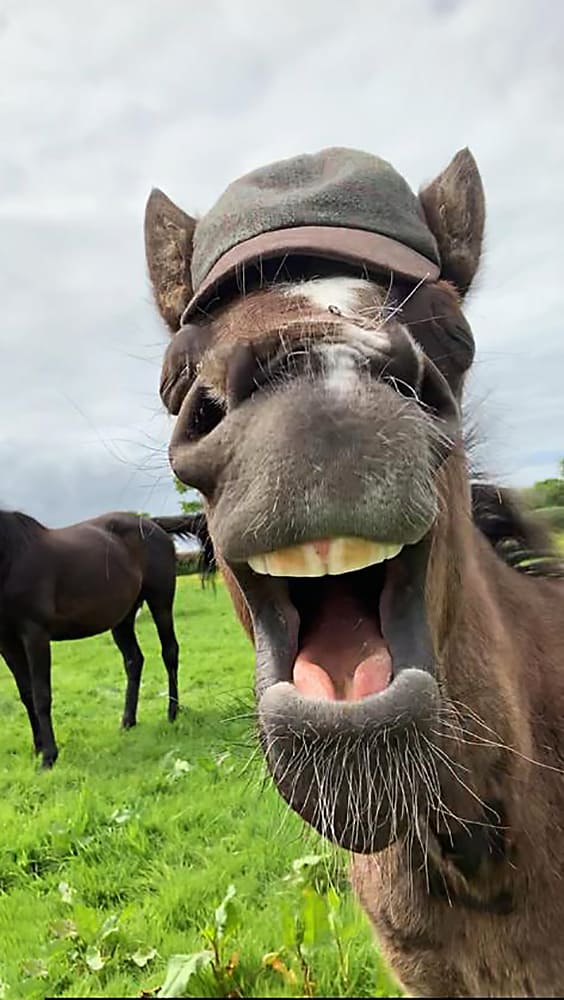Doug and Lucy reflect on the enormous joy of an ‘I made that!’ moment – even as they teach foals to pick up their feet, and hope they don’t split their stitches

You can’t keep a good horse down. Image: Lucy Procter
We can’t start this column without mentioning the passing this week of Lester Piggott – probably the greatest jockey any of us will ever see. But what people may not know is that he was also the breeder
of a number of successful racehorses, some of which he rode himself: rider-breeder is a far rarer combination than owner-breeder.

Slow June
At TGS, with the arrival of June, life at the stud changes pace. All but a handful of the mares and foals now live out 24/7, most of our seasonal boarding mares have returned home to their owners and our two seasonal members of staff have left for the summer.
With less to do during the day, I’ve had a flurry of photos of foals wearing caps and having snuggles with the staff – but none of this is time completely wasted. If the foals are well handled at this early stage, the easier they will be to handle as they mature into half ton, lively young racehorses.
At TGS this season we’ve welcomed 22 foals into the world, 24 mares have visited their chosen stallion and, at writing, 19 are confirmed pregnant. There are two late mares due to foal at the end of the month and only three mares left to cover.
Doug takes up the story:
While checking on how both the foals and the grass are growing (well for both, at the moment) I got to thinking just what do we get out of breeding racehorses?
With a horse like Honeysuckle, what we get out of it is pretty obvious; awards and column inches galore would be a buzz for anyone. But what about the others? A lot of horses never win. In fact about a fifth
never even race. So when you do breed a winner it’s quite an achievement. You can think “I made that!”. A lot of other people – bloodstock agents, trainers, jockeys, owners, old uncle Tom Cobley and all, have got to get it right along the way, but still, YOU made it.
You chose the mare. You planned the mating. You can remember the gawky youngster and what you thought about its future as a racehorse, whether they might be good. Or not. But for sheer joy and excitement, seeing a horse you bred cross the line in front of all the others, be it carrying your colours or someone else’s, is hard to beat.
The old Churchill quote “there’s something about the outside of a horse that’s good for the inside of a man (sic person?) is doubly so when you’ve bred the horse too.
But before we get too carried away dreaming, Lucy brings us back to earth with the day-to-day ups and
downs of breeding.

Image: Lindsay Swalwell
Foal in stitches
This month, one of our mares foaled her filly foal while standing up. Normally if this happens there isn’t a problem, but on this occasion, within a couple of days the foal’s stomach was noticeably distended. Our vet identified a potential issue with the foal’s bladder and arranged for a rushed admission to Western Counties Vet Hospital. An internal rupture was identified and surgery carried out.
Now home, although mother and foal can go out during the day, we have to keep them in a small grazing pen for the next month so that the foal doesn’t gallop around too fast and risk splitting her stitches. We can’t stop her leaping for joy, however (see image at the top of article), so we just have o keep our fingers crossed she doesn’t do any damage!
One of the routine jobs for us is worming, which starts at two months old, and continues bi-monthly until late autumn. We used to deworm monthly for the first year, but professional advice now is to do so every two months, the idea being to give the foals a chance to start building their own natural resistance.
Our main weapon in the battle against worms though is poo picking. We regularly remove poo from fields using poo skips and rakes, before moving the horses to a different field and then going in with the tractor to harrow and top the grass and rest the pasture for a couple of weeks before grazing again.

Image: Lucy Procter
Fancy footwork
Our oldest foals are also meeting the farrier for the first time. It’s a good idea to regularly practice picking up their feet in the stable or field, so that it isn’t a total shock when the farrier turns up to trim their hooves for the first time. Usually the foals are reasonably well behaved for the farrier, but recently one in particular wasn’t interested in standing still with her feet up for rasping. So rather than battle with her we will do daily foot-lifting practice so that hopefully, when the farrier returns in a couple of weeks, she lets him do his job.
Royal Dunfermline
With the Queen’s Jubilee upon us, and we prepare to head on up the hill opposite the stud for the lighting of the Jubilee beacon, we are reminded that her Majesty has herself been a keen owner and breeder of racehorses for most of her seventy- year reign. In fact, her most notable owner-breeder triumphs came in 1977, her Silver Jubilee year, when her homebred filly Dunfermline, won both The Oaks and The St. Leger, two of the five British Classic flat races.
Lucy Procter, co-owner of The Glanvilles Stud (TGS)





[…] rate.And happily, our foal, after post-surgery weeks in a small turn-out pen as readers will remember from last month, is now enjoying life with the rest of the gang of younger foals, stretching her legs to the full […]